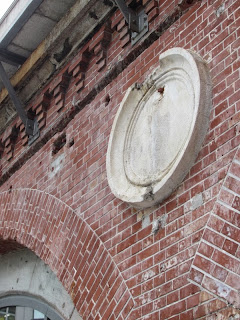秋葉原にある「マーチエキュート 神田万世橋」は
JR東日本が運営する小さくてユニークな商業施設。
去年の9月に開業したばかりですが、その建物はなんと100年以上もの歴史があります。
"MAAch ecute Kanda Manseibashi" is in Akihabara.
It's a small but unique shopping mall run by JR east.
It's new, just opened last September.
But it's also old, as the building is more than 100 years old.
万世橋からみたマーチエキュートと神田川
Kanda River and mAAch ecute seen from Manseibashi Bridge
その建物とは1912年開業の旧万世橋駅。駅は1943年に休止となりましたが、今でもこの上をJR中央線が走っています。
This building used to be Manseibashi Station, which opened in 1912.
Though the station was closed in 1943, JR Chuo line still runs on top of it.
外から見るとなるほど古い建物です。
It looks very old, doesn't it?
でも中はとってもおしゃれ。
But the shops inside are very stylish.
コーヒー、ワイン、スイーツ、お花などの小さなお店が並んでいます。
These small shops sell wine, coffee, chocolate, flowers, and so on.
川に沿ったオープンデッキ open deck along the river
夜がさらに素敵なんです。
At night, the atmosphere gets even nicer.
開業当初からある趣ある階段を上ると、
Climb up these old steps.
They are from 1912.
旧万世橋駅のホームに出られます。
And you come to the old platform.
電車がこのホームに止まることはありませんが、すぐ両脇を中央線の電車が走っていきます。
Of course, trains don't stop here any more, but you can see trains passing by on both sides.
さらにこのホームには展望カフェもあって。
You can even have drinks on that old platform.
cafe N3331
両脇を電車が走っていくのを眺めながらお酒をいただくことができます。
Can you see the trains outside?
八海山ビール。日本酒の品ぞろえも豊富なようでした。
I had Hakkaisan Beer. They have good selections of Sake, too.
さすが中央線。電車はひっきりなしに走っていきます。
忙しい電車を見ながら、のんびりビールを飲むのはなんだか気持ちよかったです。
Chuo Line is a very busy line, so trains were constantly passing by.
It was a lot of fun drinking leisurely, looking at busy trains.
さて、いい気持ちになったところで、おうちに帰りましょう。
秋葉原駅に向かいます。
It was time to go home.
Feeling happy, we headed back to Akihabara Station.
夜の眺めはしっとりとしています。It looks very chic at night
ところが、目の前には…\(◎o◎)/!
Then, I turned around, and... \(◎o◎)/!
秋葉原の街はぎらぎらです!
Akihabara is so bright and loud!!
あまりのギャップにびっくりしました。
秋葉原。面白い街ですね。
でも個人的にはやはりマーチエキュートのほうが好みかな?(^^)
It was so different!
Akihabara is such an interesting place.
But to be honest, I like mAAch ecute better. (^^)
.jpg)
.jpg)
.jpg)
.jpg)
.jpg)
.jpg)
.jpg)
.jpg)
.jpg)
.jpg)
.jpg)
.jpg)
.jpg)

.jpg)
.jpg)
.jpg)


.jpg)
.jpg)
.jpg)
.jpg)
.jpg)
.jpg)
.jpg)
.jpg)
.jpg)
.jpg)
.jpg)
.jpg)
.jpg)
+-+%E3%82%B3%E3%83%94%E3%83%BC.jpg)
.jpg)
.jpg)
.jpg)
.jpg)
.jpg)
.jpg)
.jpg)
.jpg)
.jpg)
.jpg)
+(2).jpg)
.jpg)
.jpg)